When you’re renting, you tend to feel like there’s no glory in gardening. It’s hard work, you often have to leave it behind. I decided to stop dreaming, and start doing. Here’s where it all begins.
Gardening is a noble pursuit – but for tenants it can be awfully demoralising
While I was on holidays, I came to decide that gardening really is a noble pursuit. And since I’ve been back at home, gardening has become an active and purposeful thing for me. Having a productive and successful garden is one of the many goals I have taped next to my bathroom mirror.
The tenanted yard is usually dead, hardened, and uncared-for beyond water & lawn cutting
The problem with creating a happy and productive garden is that, at my house, as with many tenanted properties in Adelaide, the yard is a bland, nutrient-devoid space. Filled with couch grass (buffalo grass to you guys in the northern hemisphere), which is nearly the only thing that will cover the ant-infested, friable, clay/sand, dead dirt, it’s hardly ever been watered. And it’s probably never been fertilised, aerated, or loved. Treating the ground before putting anything in it and expecting it to grow is back-breaking work. For a start, you have to aerate the ground, you have to pull out the couch grass (which can root in down to 15 cm) by hand.
You could poison the couch with glyphosate, if you’re the kind who likes to have carcinogenic substances sprayed around where you live, walk, and expect to grow your food. But that kind of thing really ain’t my bag; I’d rather do the work required, and be satisfied with healthy food, than to dump a truckload of chemicals around myself.
Not to mention the fact that glyphosate kills everything, including beneficial soil bacteria, beneficial insects, etc etc. /end rant/
Until you realise that you can work with couch grass, not against it
Why do we struggle so much, and make ourselves struggle so much, when it comes to crap gardens and bad plants? Isn’t it easier to work with something instead of against something?
You bet. Couch grass is fantastic at doing what it sets out to do, which is to cover bare ground. All you need to do is give it conditions it doesn’t like; while it won’t go away, it will be less difficult to work with.
The path to Struggletown is like this:
- Smother and/or pull out the couch grass runner by runner
- Wait and watch for four months
- Smother and/or pull out the couch grass runner by runner
- Keep waiting and watching
- Turn in nutrient-rich manure and compost, worms, break the clay up with lime
- Eventually hope for clear ground in which to plant.
But waiting can be a source of suffering all on its own. Not to mention that you’ve then spent about a year doing nothing valuable to the earth in serious terms. All you’ve been doing is eradicating things.
Wouldn’t it be better to work with what you’ve got?
Knowing that couch grass likes bare earth and is easier to pull out of well-conditioned soil, all you have to do is build the garden on top of the couch, whilst simultaneously smothering it and making its environment unpalatable.
There are good reasons why tenants don’t garden
The primary reason is because they don’t own it. As the saying goes, nobody has ever washed or cleaned their hire car. I actually believe that the style of renting in Australia is constructed in order to make people feel transient, and that agents, owners, and landlords enjoy the power they have over others. But that is for another post, another time.
Renting is discouraging for gardeners
Thanks to the places that I’ve lived in since leaving home at the age of 18, my ability to do any useful or effective gardening (i.e. gardening that creates food) has been restricted. Space restrictions have meant that I’ve only had miniature pots with herbs; included gardeners have meant that putting anything into the yard is verboten or totally discouraged; hill-side bush dwellings have had bush blocks that require landscaping if you’re going to grow anything in them.
Also, there’s the the temporary nature of being a tenant. I dare say that I speak on behalf of tenants everywhere about feeling disinclined to cultivate or look after yards, because there is no incentive to do so. That, and knowing that you will eventually have to bid your beloved garden a teary farewell, only to start again elsewhere, is quite simply a disappointing, grief-stricken situation waiting to happen.
So you don’t bother. And then the next tenant doesn’t bother. And the next one. And the next one. And then the yard is sad, unloved, and hard work for the one person who comes in with a different attitude.
Choosing to cultivate a garden is like choosing to make any place you live in your home
People say, ‘home is where the heart is’ but they’re liars. Very few people turn their rentals into homes. They don’t do anything with the interior design; they don’t do anything with the gardens.
And yet, renting is actually a lifestyle choice. Many of us have no choice. If the only way you can buy property is to lock yourself into a 20 to 40-year mortgage, people like me could easily be dead or widowed before we even get close to owning anything.
That’s why choosing to make any place you live in awesome is the only choice you have. Your life is lived in every moment, not in some fictional future time. The future doesn’t exist, only now does.
The first thing to do is get rid of the idea of digging into the dirt
In the typical, dead, tenanted yard, there is still a glimmer of hope. That glimmer of hope is raised bed gardening. Or, if you have a terrible couch problem like I do, raised bed gardening combined with strawbale gardening.
Add into the mix some pots, plans for vertical gardens, and indoor plants, and you’ve got yourself the beginnings of something you’d be happy to spend every moment in.
Over 2014-15 I spend a whole lot of time unsuccessfully trying to garden into the soil. So I’ve started building raised beds, and planting (and potting) trees. Fruit trees, to be precise. Even if I can’t take them with me in the unlikely event we will have to move, planted trees make such an important contribution to the health of the environment: They improve oxygen, reduce carbon dioxide, cool the environment, improve the soil, and a whole host of other things besides.
Creating a raised garden bed over couch grass
Here’s how my first garden bed was built. By the time I was finished, this is what it looked like:
The raised bed is full do-it-yourself glory. Here’s how I built it:
Ingredients
- 1 broken bookcase
- 12 nails
- 2 bales of straw (I used sugarcane)
- Dynamic Lifter
- About 7 copies of The Advertiser and about 5 copies of the Weekend Australian (glossy inserts removed from both)
Total cost
- Less than $70 in materials (yup, this includes the nails – I didn’t have any)
- Less than an hour of your time
How to do it
The first thing you need to do is make sure you have the boundaries of your garden. This means nailing your bookcase together in a square, or rectangle or whatever shape you’re making. Because I’m not particularly brilliant at banging things together, a rectangle was fine for me.
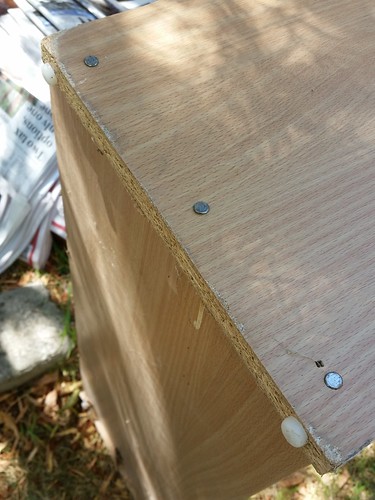
Then you need to put it in a good spot. My backyard has a shady spot in the summer, thanks to a large deciduous tree, and half of the yard is baked solid thanks to no shade. The sunny part of the yard is also the part that gets totally waterlogged in the winter, so doing anything with it is kind of out of the question.
The shady part it was. It also happens to be the flattest piece of yard, and an area close to the kitchen. So, winning!
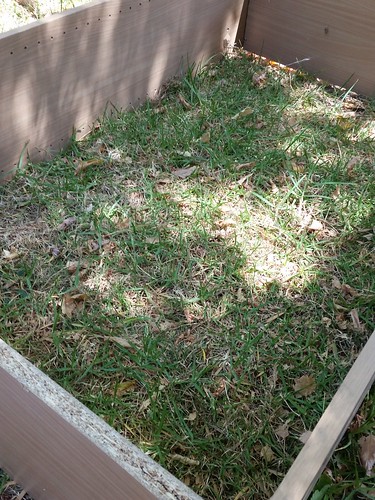
The next thing to do is smother the couch. When doing this, you need to use whole newspapers. Not parts of them. Not just little pieces of them. But the thickest, fattest newspapers you can find. That’s why I waited for the weekend papers.
When you put them into the bottom, they absolutely have to overlap. You are trying to make an environment that allows no light, no air, no gaps – or, as few gaps as possible. Smothering couch grass has to be as complete as possible. By the time I had finished, the newspaper layer was easily a full inch thick, maybe more. When it was all in place, I watered it down, to compact it down even further.

Then, fill it with straw. Before you start, it helps to know some things.
- If all the straw is vertical, the water is going to run straight through it (Bad)
- If all the straw is flat, it will be harder for the water to run away on you (Good)
- If you use hay or lucerne it might still have seeds and weedy things in it (Bad)
- If you use straw or sugarcane it won’t have seeds and weedy things in it, and will help suppress weeds (Good)
- You need a lot of straw. Under-estimating is bad, over-estimating is good.
- You will want to plant in it straight away (Bad)
- It needs to rot a bit in the centre before you can plant in it (Good)
Knowing these seven points, layer your straw in, taking care to eliminate all the gaps. Every time you’ve put in a substantial amount (say a hand’s width deep), water it down.
You will need to fill it right to the top of, possibly higher than, your garden bed sides. Your garden bed will compact down over time as it decomposes and turns back into soil. It’s a great thing, because it is simultaneously conditioning the soil underneath.
This is what mine looked like when it was full:
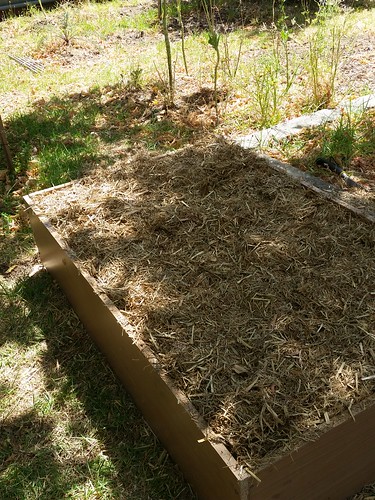
Then you only have two things left to do. The first is to spread your Dynamic Lifter over the top. This will add the vital nitrogenous compost that it critically needs, and which it can’t get from your own compost (because you don’t have any yet). The Dynamic Lifter is pelleted compost comprised of blood and bone, seaweed, and chook shit.
It smells phenomenally bad, but insects and the flies love it, and it helps to heat up and decompose the centre of your strawbale bed. What it will do is heat up, rot a bit, and cool down. It’s only then that you can plant things in it, otherwise you might fry your poor little seedlings.
Then, water it in. Then come back to it in a few hours if it’s hot (like it is here) and water it again. You absolutely have to keep it moist, or it will not rot in a pink fit.
While you’re at it, go and fertilise and mulch anything else you’ve neglected in your yard, while you’ve got the Dynamic Lifter and leftover straw handy.
I even went so far as to plant in a mint plant. I know they tend to take over, but I would far rather be mowing a mint lawn, than a couch grass lawn. At least it would both smell fantastic and be edible. My favourite Kylie gave me this tip: Mint crowds out couch. Try anything once, right?
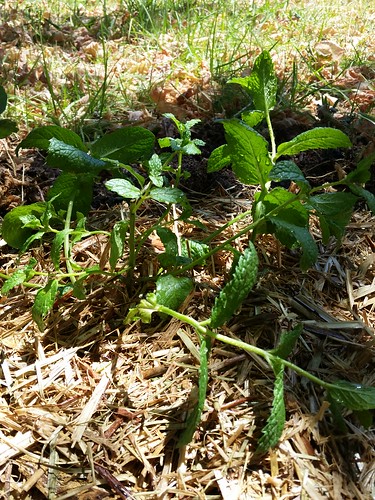
Some other tips of which to take note
So much of gardening is about trial and error. And, as my mum so aptly pointed out, in her Zen-like way:
That’s the beautiful thing about gardening. If it dies, you can always start again.
~ my mum
Anyway, here’s what I’ve learned in my scant 12 months of trying to cultivate a rented yard:
- Only ever plant when the moon is between the new moon and a full moon. Moon phase planting is powerful, for a very real reason: During a waxing moon, gravity pulls sap down towards the roots of a plant. During a waning moon, gravity relaxes its grip and sap tends to be more in the foliage. When you sow your plants, you want them to have the greatest possible chance of establishing a good root system, so go with nature yeah?
- Bare soil is shit. If you have open ground, for the love of your garden, cover it with mulch. Also, it saves water.
- In Australia – especially in Adelaide, where it’s as dry as a nun’s nasty – take “full sun” with a bucket of salt. Or at least do some research. Cane berries, for example, say ‘full sun’; but they get burnt foliage really easily, so at least put them in dappled shade.
- Training potted trees with bonsai wire is fantastic for new growth and greater yield.
That last point comes from notions of creating espaliered gardens: A method of training your plants to maximise sunlight. It tends to increase yields of all kinds of plants. If you’ve ever seen plants trained in fans, or across fences or walls, that’s the kind of thing I’m talking about.
It’s also a fantastic way of training your attention and focus because you have to think about it pretty carefully to make sure you get the balance right. Here’s my lemonade lemon, which I started training with wire only a few months ago. It exploded with new growth not long after I first trimmed and trained it:

So that’s the start of my second year of taking gardening seriously. I’m already thinking about my second raised bed, because one won’t be enough to eat from substantially. My intention is to put in a new raised bed once per month. And if I can match the decomposition/planting with the moons, even better.
Do you rent but still garden?
What have you found: Good, bad, ugly, happy, sad? Any tips for other renters, or raised bed gardeners? Leave your comments below. 🙂

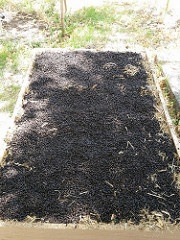
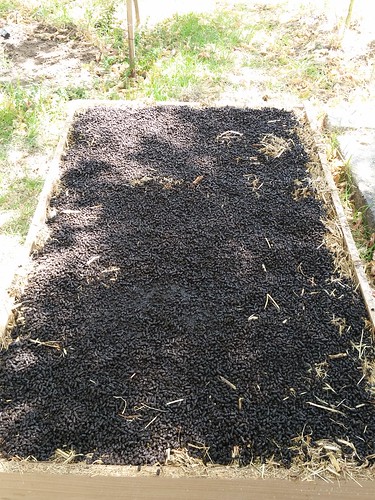
RT @biodagar: Just posted! Renting? You can still build an awesome garden (https://t.co/HvonM9ISlQ) – Pls RT
Renting? You can still build an awesome garden https://t.co/qKZdmbjppz https://t.co/LXukJZtVni